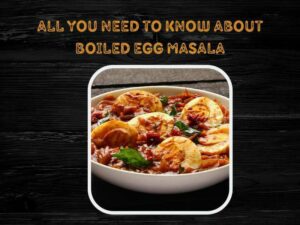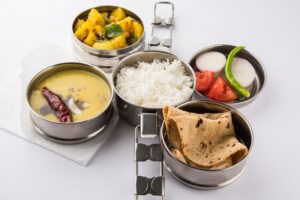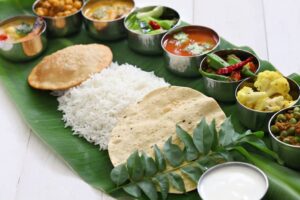When you’re determined to make baked yellowtail, first of all, be sure you know which fish you’re dealing with. Yellowtail is a name that can apply to flounder, sole, snapper, or tuna.
The point about which is that you’d cook snapper very differently from sole, so you have to be sure what you actually have in front of you if the recipe you’re following is going to make any sense.
The question is confused even further by the fact that Yellowtail is also the name for several varieties of Amberjack, which is a fish that’s like tuna, without in any real sense being tuna, regularly caught off California and the Baja coast.
So, first of all, choose your Yellowtail.
One of the best Yellowtails for home baking is the Yellowtail Snapper. That’s a fish that benefits from the baking technique, and from the grandeur of whole-fish cookery, unlike the Amberjack, that tends to demand filleting before you bake it.
Let’s go the spectacular route with:
Baked Whole Yellowtail Snapper
One of the big pluses about baking a fish whole of course is that you get the spectacular look of the dish, without in fact having to use a recipe with 36 stages.
Baked whole Yellowtail Snapper is simplicity itself, but one of the keys is that it gets a whole lot easier if you get your fishmonger to do some of the work for you before the fish even gets into your kitchen.
At the supermarket:
Get your fishmonger to clean, gut, and scale your Yellowtail Snapper. That just saved you a whole lot of prep time, as well as three of the messier jobs of fish cookery.
It also means that you don’t need to pretend to be an expert fish-gutter – your fishmonger should have the skills, and the knives, to do this job faster, cleaner, and more thoroughly than you could ever guarantee in your kitchen. Let the fish guru be the fish guru.
Ingredients:
- 1 Yellowtail Snapper
- Enough butter to melt as the base for a flavoring that will be brushed onto and inside the fish.
- Garlic powder
- Minced garlic
- Salt (ideally sea salt)
- Pepper
- Fresh herbs or Italian seasoning
- 2-3 lemons, to taste – you’ll need some lemon slices and some lemon juice
Method:
- Get your oven preheating to 400F. Yes, really, it makes a difference.
- First, make your seasoning mixture.
You can choose your ingredients, but I like to melt some butter and add salt, pepper, garlic (powder, in this instance), Italian seasoning, or fresh herbs if in season (if fresh herbs, chop them finely before adding to the butter), and a squeeze of lemon juice.
This acidulated, herby liquid butter will both flavor the fish and give it an additional zing to cut through the richness of the flesh flavor and enhance the overall flavor profile.
- Put the seasoning to one side for a moment.
- Pat your fish dry – it will hold your seasoned butter better that way.
- Lightly oil a foil-lined baking sheet.
- Place the fish on the foil-lined baking sheet, with the head up if possible. This will help the presentation and will avoid uneven cooking, or the need for turning during the cooking time.
- Make three or more slits in the flesh down each side of the fish. The number of slits only depends on how much lemon you want to add to the outside of the fish.
- Brush the fish all over with your flavor mixture. Also brush inside the cavity, so that the flavor penetrates and permeates the whole of the dish.
- Add any additional flavoring ingredients, like lemon slices, chopped garlic, or onion slices, to the cavity of the fish to boost flavor and add complexity.
- Insert lemon slices into the slits you made in the outside flesh of the fish. They will acidulate the flesh a little as it cooks, tightening it and adding to the flavor.
- In addition to the wet flavoring and the aromatics added to the cavity, dush the outside of the fish with additional herbs or spices to taste.
Paprika and parsley makes a surprisingly effective combination with Yellowtail. This dry flavor round is also a good opportunity to add any additional seasoning, like extra salt and pepper.
- Put the fish into your pre-heated oven for around 30 minutes or until the flesh is flaky.
- Drizzle with extra lemon juice (yes, it’s heavy on the lemon, this dish). The lemon might seem like overkill, but because Yellowtail is a fairly mild and mellow-flavored fish, it will actually lighten it and bring the flavor of the fish more to the fore.
Feel free to also baste the fish with any of the cooked flavoring mix, to re-enhance those notes.
- Serve.
What you serve it with is up to you. Because the flavor is quite light and mild, ideally, the more spring and summer flavors you add to it, the better it will go.
So, simple salads, maybe with the roar of radish, the mellow salt of feta, and the explosive zing of cherry tomatoes, would suit this fish dish extremely well.
You can roast potatoes alongside the fish, but if you’re going to do that, I’d say keep them small, and new.
If you’re going to go with potatoes, you could find that boiling a small handful of new potatoes and just adding a knob of salty butter to serve might give you a more pleasingly light accompaniment.
Alternatively, and probably better than potatoes at all with this dish, go with a grain. Try a couscous, so you feel you’ve had some sort of starch element, but you don’t weigh the delicate fish flavor down.
As we said at the start, there are various fish that go by the name of Yellowtail, and you’ll find favorite recipes for each of them.
Many of them will benefit from a preparation similar to this crowd-pleasing Yellowtail Snapper dish – keeping the flavors high, zingy and simple, to complement the fish.
The Tuna and Amberjack versions of Yellowtail might benefit from some lower notes in your wet flavoring, and you might want to back off the paprika in the tuna too, unless you add a more acidulated oil to the mix.
But as a preparation for Yellowtail Snapper, this simple citrus, garlic and herb flavor baked whole fish is hard to beat.










